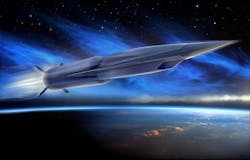Deadline extended for project to develop sensors that operate at extreme temperatures for hypersonics
ARLINGTON, Va. – U.S. defense technology companies interested in developing electronics for extremely hot environments have an extra two weeks to respond to a military research project to develop sensors like transducers and signal-conditioning microelectronics that can operate at extreme temperatures of at least 800 degrees Celsius for future hypersonic and jet engine applications.
Officials of the U.S. Defense Advanced Research Projects Agency (DARPA) in Arlington, Va., issued a broad agency announcement in May for the High Operational Temperature Sensors (HOTS) program. The response data has been extended from 15 to 31 Aug. 2023.
For demonstration purposes, DARPA wants industry to develop a pressure sensor module with an integrated transducer and signal-conditioning microelectronics.
Physical sensors that can operate in the high-temperature environment will enable systems to operate closed-loop with accurate state-of-health monitoring.
Many commercial and defense systems such as hypersonic aircraft and missiles, automotive, jet engine turbine, and oil-and-gas systems experience thermal environments beyond the capability of today’s high- performance physical sensors, DARPA researchers explain.
Yet today's state of the art typically cannot operate in temperatures higher than 225 C because of intrinsic limitations to their complementary metal oxide silicon (CMOS) materials.
The HOTS program will develop a technology for high-bandwidth high-dynamic-range sensing that operates at temperatures of 800 C and hotter.
While wide-bandgap materials like silicon carbide (SiC) or gallium nitride (GaN) have potential for use at high temperature due to their significantly lower intrinsic carrier concentration, today they do not support sensor microelectronics with high bandwidth and large dynamic range at high operating temperature for useful lifetimes.
At high temperatures these materials can crack because of their coefficients of thermal expansion. They also can leak current because of the increase in thermal carriers.
To overcome these kinds of thermal limitations, HOTS seeks to overcome three key technical challenges: achieving long lifetime and large bandwidth transistors at high temperature; achieving a high-sensitivity transducer at high temperature; and integrating a high operating temperature sensor without degrading performance.
HOTS will be a 36-month program broken into two phases, which will begin in January 2024. DARPA will brief industry on the HOTS program from 8 a.m. to noon on 31 May 2023 at the Booz Allen Hamilton Auditorium, 8283 Greensboro Drive, in McLean, Va. Register no later than 25 May 2023 online at https://web.cvent.com/event/ea5d72ae-6f18-4d62-b112-545ac23d3f32/summary.
Companies interested in participating in the DARPA HOTS program were asked to submit abstracts in June, and full proposals no later than 31 Aug. 2023, to the DARPA BAA website at https://baa.darpa.mil.
Email questions or concerns to DARPA at [email protected]. More information is online at https://sam.gov/opp/6852d7443f7344c083960d1753269f57/view.
About the Author
John Keller
Editor-in-Chief
John Keller is the Editor-in-Chief, Military & Aerospace Electronics Magazine--provides extensive coverage and analysis of enabling electronics and optoelectronic technologies in military, space and commercial aviation applications. John has been a member of the Military & Aerospace Electronics staff since 1989 and chief editor since 1995.

